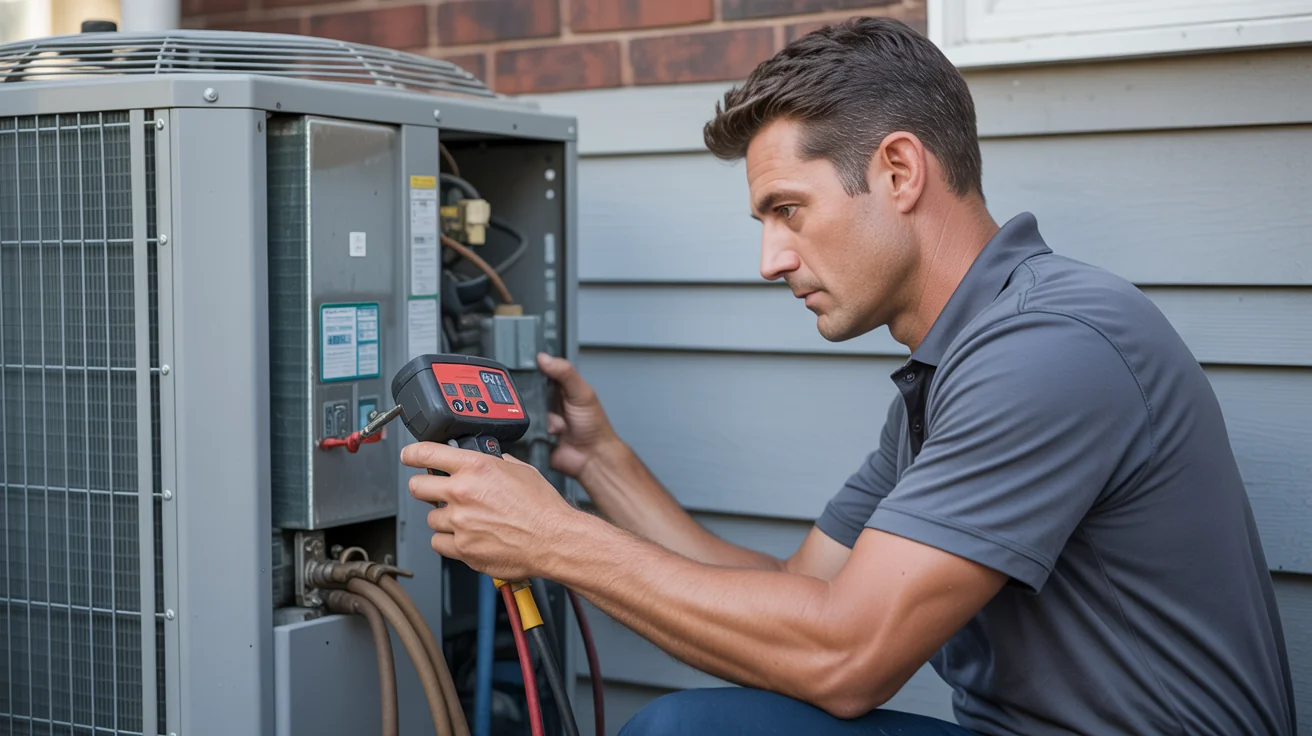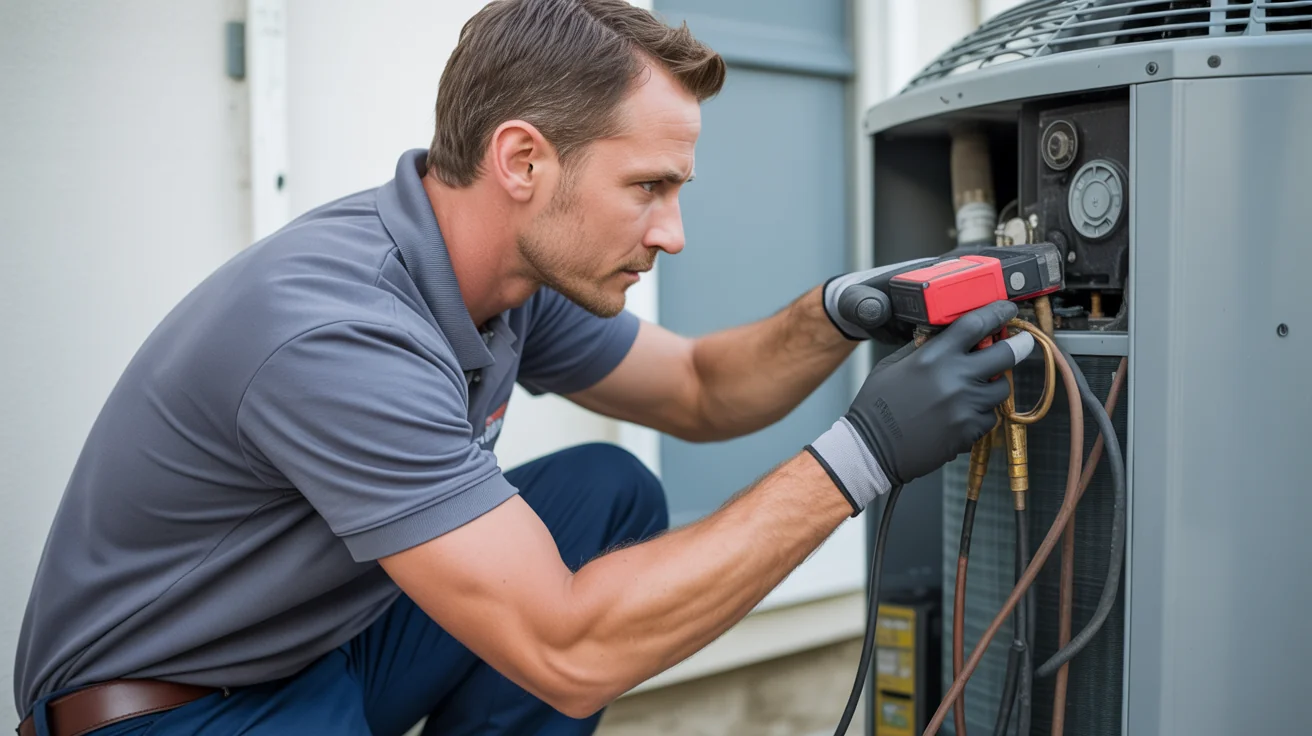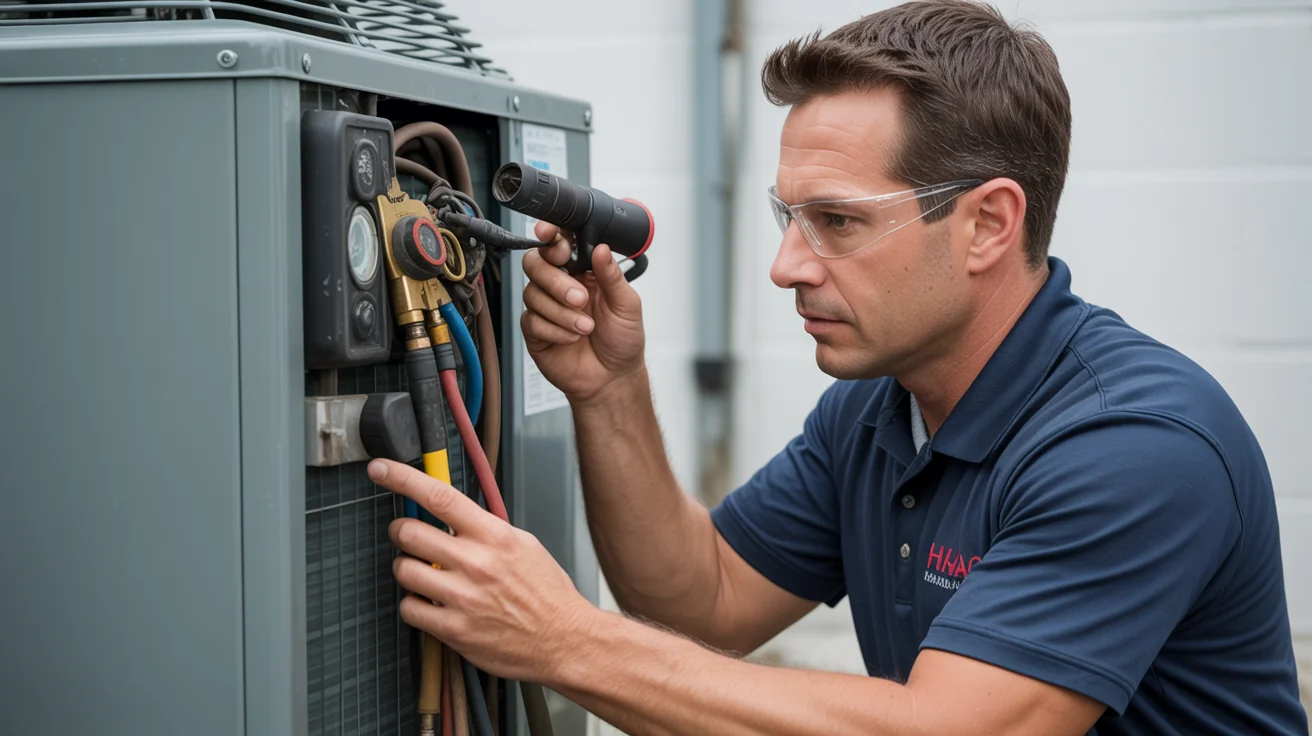Monthly HVAC Maintenance Checklist North Texas Homeowners (2025): Complete DIY Guide & Professional Service Schedule
Comprehensive monthly HVAC maintenance checklist for North Texas climate. DIY maintenance tasks, professional service schedules, and seasonal optimization.

The $15 Filter That Could Have Saved $3,200
Last month, I got an emergency call from a Plano homeowner on the first 100-degree day of summer. “My AC just died and it’s already 95 inside!”
When I popped the hood on their outdoor unit, I found the compressor - the heart of the system - completely seized. Total repair cost: $3,200. The cause? A filter so clogged you couldn’t see through it. When was the last time they changed it? “Oh, I think maybe six months ago?”
That $15 filter change would have prevented a $3,200 disaster.
Look, I see this story every week. Homeowners who think monthly maintenance is optional, then get shocked by emergency repair bills that could have bought them a nice vacation. After 15 years diagnosing these preventable disasters, I can tell you exactly which simple tasks prevent expensive failures.
This checklist takes less than an hour a month but can save you thousands in repairs. More importantly, it keeps your family comfortable when North Texas weather gets extreme.
Why Your System Works Harder Than Equipment Anywhere Else
North Texas isn’t just tough on people - it’s brutal on HVAC equipment. Here’s what your system faces that homeowners in Denver or Seattle can’t imagine:
During no break season, your equipment runs 8+ months straight, and some years, I’ve seen systems that never truly shut down. Dust bowl conditions from West Texas dust plus East Texas pollen create a filter-clogging nightmare. The thermal shock from 105°F to 45°F temperature swings stress components beyond design limits. Swamp-level humidity from summer moisture creates perfect conditions for mold, corrosion, and electrical failures. During hail season, I’ve replaced more outdoor units destroyed by Texas storms than I can count.
Here’s the Reality: The families who do monthly maintenance call me for routine service. The families who skip it call me for emergencies that cost three times as much and happen at the worst possible times.
Understanding HVAC Maintenance Fundamentals
Why Monthly Maintenance Matters
Equipment Protection Benefits:
Preventing costly failures through early detection saves thousands in repair costs. Regular care extends equipment life by 5-8 years to system lifespan. Maintaining efficiency means clean, well-maintained systems use 15-25% less energy. Preserving warranties requires regular maintenance documentation as manufacturer warranties mandate this record-keeping.
Comfort and Safety Advantages:
Consistent performance prevents hot/cold spots and comfort complaints throughout your home. Indoor air quality improves significantly with clean filters and coils that remove contaminants effectively. Safety assurance comes from early detection of potential safety hazards before they become dangerous. Emergency prevention helps you avoid system failures during extreme weather when you need comfort most.
DIY vs. Professional Maintenance
Homeowner Monthly Tasks (30-60 minutes):
- Filter inspection and replacement
- Visual equipment inspection
- Basic cleaning and debris removal
- Performance monitoring and documentation
Professional Service Tasks (Seasonal):
- Detailed component inspection and testing
- System cleaning and lubrication
- Electrical connections and safety checks
- Refrigerant level verification and adjustment
Complete Monthly Maintenance Checklist
Indoor System Maintenance (15-20 minutes)
Air Filter Inspection and Replacement:
- Turn off system: Switch thermostat to OFF position for safety
- Locate filter: Find filter slot in return air grille or furnace unit
- Remove filter: Note airflow direction arrow before removal
- Inspect condition: Hold filter up to light to check for blockage
- Replace if needed: Install new filter with correct airflow direction
Filter Replacement Guidelines: Standard 1” filters need replacement monthly during peak seasons when system usage is highest. Pleated filters should be changed every 60-90 days depending on conditions and household factors. High-efficiency filters require following manufacturer recommendations for optimal performance. For multiple filters, check all filter locations throughout your system to ensure complete coverage.
Indoor Unit Visual Inspection:
- Check for leaks: Look for water around indoor unit or drain pan
- Listen for noise: Note any unusual sounds during operation
- Inspect vents: Ensure all supply and return vents are unobstructed
- Test airflow: Feel for adequate airflow from supply registers
- Check thermostat: Verify proper operation and battery condition
Safety Checks: Check electrical panels to ensure HVAC breakers are secure and not tripped, which could indicate system problems. Inspect gas connections by checking for gas odors near the furnace, and call a professional immediately if any are detected. Test your carbon monoxide detector operation and battery condition to ensure family safety. Locate and verify that gas and electrical shutoffs are accessible for emergency situations.
Outdoor System Maintenance (15-25 minutes)
Condensing Unit Inspection:
- Clear debris: Remove leaves, grass, and debris from around unit
- Check clearances: Maintain 2+ feet clearance on all sides
- Inspect refrigerant lines: Look for damage or exposed insulation
- Clean coil fins: Gently straighten bent fins with fin comb
- Test fan operation: Verify fan runs smoothly without wobbling
Outdoor Unit Cleaning:
- Turn off power: Switch off unit at electrical disconnect
- Remove debris: Clear leaves and debris from inside unit
- Hose down coils: Gently spray coils from inside out (low pressure)
- Clean drain pan: Remove standing water and clean with mild soap
- Restore power: Turn unit back on and check operation
Seasonal Outdoor Considerations:
Spring/Summer Focus:
Coil cleaning becomes essential due to pollen and dust accumulation that reduces system efficiency. Refrigerant line inspection should check insulation for UV damage from intense summer sun exposure. Electrical connections need verification for tight connections after winter expansion and contraction cycles. Drainage verification ensures proper condensate drainage to prevent water damage and system problems.
Fall/Winter Focus:
Leaf removal keeps the unit clear of falling leaves that can block airflow and reduce efficiency. Wind protection involves checking for storm damage or loose components that could affect system operation. Ice prevention requires monitoring for ice formation during freeze events that could damage equipment. Cover considerations are important, but never fully cover an operating unit as this restricts necessary airflow.
Ductwork and Ventilation (10-15 minutes)
Visual Ductwork Inspection:
- Accessible ducts: Inspect visible ductwork for damage or disconnection
- Insulation check: Look for missing or damaged duct insulation
- Support verification: Ensure ducts are properly supported
- Leak detection: Feel for air leaks at connections and joints
- Pest inspection: Check for signs of rodent or insect activity
Ventilation System Maintenance: Clean bathroom fan exhaust fan grilles and test operation to ensure proper moisture removal. Maintain kitchen ventilation by cleaning range hood filters and fans to remove cooking odors and grease. Service whole-house ventilation by checking ERV/HRV filters and operation for optimal air exchange. Verify attic ventilation by ensuring ridge and soffit vents are unobstructed for proper air circulation.
Performance Monitoring and Documentation
Monthly Performance Testing:
- Temperature differential: Measure supply vs. return air temperature difference
- Airflow assessment: Check airflow strength at multiple vents
- Operating sounds: Note any new or unusual system noises
- Cycle timing: Monitor how long system runs to reach setpoint
- Energy usage: Track monthly energy consumption patterns
Maintenance Documentation: Maintain a service log to record all maintenance activities with dates for warranty and troubleshooting purposes. Track filter changes by recording filter replacement dates and types used for optimal system performance. Document performance notes about any changes in system operation to identify developing problems early. Note problem identification issues for professional service to ensure proper repair planning. Monitor energy tracking through monthly utility bills to identify efficiency trends and potential problems.
Seasonal Maintenance Priorities
Spring Preparation (March-April)
Cooling System Startup: Schedule deep coil cleaning with professional cleaning after pollen season to remove accumulated debris. Perform refrigerant checks to verify proper levels after winter storage and ensure optimal cooling capacity. Service electrical connections by tightening connections and testing controls for reliable operation. Complete thermostat calibration by switching to cooling mode and testing operation for accurate temperature control.
Enhanced Monthly Tasks: Increase filter frequency with weekly checks during high pollen periods when airborne contaminants peak. Perform daily debris removal by monitoring the outdoor unit for pollen accumulation that can reduce performance. Maintain drainage monitoring to ensure condensate drains are clear and flowing properly. Establish an efficiency baseline with spring/summer performance benchmarks for future comparison.
Summer Maintenance (May-September)
Related: Summer Maintenance
Peak Performance Period: Conduct weekly outdoor unit inspection as high usage demands frequent monitoring for optimal performance. Schedule filter changes every 30 days minimum during continuous operation to maintain airflow. Perform coil maintenance with monthly outdoor coil cleaning during dust season to preserve heat transfer efficiency. Implement performance monitoring to track cooling efficiency and energy usage for cost control.
Heat Stress Management: Verify shade to ensure the outdoor unit has adequate shade protection from intense summer sun. Protect refrigerant lines by verifying insulation integrity to maintain system efficiency. Monitor electrical systems by watching for high-temperature electrical issues that can cause failures. Maintain emergency preparedness by having a backup cooling plan for system failures during peak heat.
Fall Preparation (October-November)
Related: Fall Preparation
Heating System Preparation: Schedule furnace inspection with professional inspection before heating season begins. Perform heat exchanger checks for carbon monoxide safety verification to protect family health. Complete ductwork winterization by sealing and insulating accessible ducts for efficiency. Execute thermostat transition by switching to heating mode and testing operation for reliable heating.
System Transition Tasks: Perform complete cleaning with deep cleaning of the entire system before heating season begins. Schedule lubrication service for professional lubrication of moving parts to ensure smooth operation. Conduct safety testing to test all safety systems and alarms for family protection. Complete fuel system checks including natural gas connections and propane levels for reliable heating fuel supply.
Winter Maintenance (December-February)
Cold Weather Operations: Give heat pump attention by monitoring defrost cycles and ice formation for proper winter operation. Provide furnace monitoring by watching for proper ignition and heat distribution throughout the home. Manage humidity by balancing heating with proper humidity levels for comfort and health. Maintain emergency preparedness with backup heating options for power outages or system failures.
Reduced Activity Period: Continue monthly basics including filter changes and basic maintenance throughout the winter season. Prepare for storms by clearing snow and ice from outdoor equipment to maintain proper operation. Monitor efficiency by tracking heating costs and system performance for budget planning. Plan ahead by scheduling spring maintenance and equipment evaluations before the next cooling season begins.
Professional Maintenance Integration
When to Call Professionals
Immediate Professional Service: Address safety concerns immediately, including gas leaks, electrical issues, or carbon monoxide detection that threaten family safety. Investigate major performance changes such as sudden efficiency loss or inadequate heating/cooling capacity. Listen for strange noises including grinding, squealing, or banging sounds that indicate mechanical problems. Inspect for visible damage including refrigerant leaks, damaged coils, or electrical problems requiring professional attention. Monitor for high energy bills with unexplained increases in utility costs that suggest system inefficiency.
Scheduled Professional Maintenance: Schedule bi-annual tune-ups with spring and fall professional service visits for optimal system performance. Arrange annual deep cleaning with complete system cleaning and inspection to maintain efficiency. Ensure safety inspections with annual safety system verification to protect family health. Implement performance optimization through professional system balancing and adjustment for maximum comfort and efficiency.
Professional Service Schedule
Spring Service (March-April): Complete cooling system preparation with thorough AC startup and inspection procedures. Provide refrigerant service including level verification and leak detection for optimal performance. Perform electrical testing with connection tightening and component testing for reliable operation. Establish performance baselines with seasonal efficiency benchmarks for ongoing monitoring.
Fall Service (September-October): Execute heating system preparation with complete furnace inspection and startup procedures. Conduct safety verification including carbon monoxide and gas leak testing for family protection. Perform heat exchanger inspection with professional safety evaluation to prevent dangerous conditions. Complete system optimization through airflow balancing and control calibration for efficient operation.
Maintenance Agreement Benefits
Jupitair’s Maintenance Agreement: Members receive priority service with faster response times when HVAC issues arise. Enjoy discounted repairs with 15% discount on all repair work throughout the year. Benefit from annual inspections with complete bi-annual system evaluations for preventive care. Receive performance guarantees including efficiency and comfort assurance for peace of mind.
Member Exclusive Services: Access 24/7 emergency priority with faster emergency response when systems fail. Receive advanced diagnostics with comprehensive system analysis using professional equipment. Benefit from predictive maintenance with early problem detection and prevention strategies. Enjoy energy optimization with seasonal efficiency improvements that reduce utility costs.
Common Maintenance Mistakes to Avoid
DIY Maintenance Errors
Filter Mistakes: Avoid wrong size filters as gaps allow bypass and reduce effectiveness of air filtration. Prevent backward installation since incorrect airflow direction reduces system efficiency significantly. Don’t make infrequent changes as dirty filters damage equipment and waste energy through reduced airflow. Avoid over-efficient filters because restricting airflow can damage blower motors and reduce system performance.
Cleaning Errors: Never use high-pressure washing as it damages delicate coil fins and components beyond repair. Avoid chemical cleaners since household cleaners can damage equipment and void warranties. Keep water away from electrical components by never spraying water near electrical areas. Prevent aggressive cleaning since bent fins and damaged components result from rough handling during maintenance.
Professional Service Mistakes
Contractor Selection Errors: Avoid unlicensed technicians by always checking TACL licensing before hiring contractors. Don’t focus solely on the lowest bid as quality service requires fair compensation for skilled work. Consider maintenance agreements to avoid missing preventive care opportunities that save money long-term. Don’t delay service by waiting for failures instead of preventing them through regular maintenance.
Emergency Preparedness
Preventive Emergency Planning
Emergency Scenarios: Prepare for complete system failure by developing backup cooling and heating plans for family comfort. Plan for power outages with generator compatibility and priorities for essential system operation. Establish refrigerant leak procedures with immediate response protocols to minimize environmental impact. Create gas leak safety protocols with emergency contacts readily available for dangerous situations.
Emergency Supplies: Stock backup filters by keeping a 3-month supply of correct filters for uninterrupted maintenance. Maintain basic tools including screwdrivers, wrench set, and flashlight for minor maintenance tasks. Keep emergency contacts including Jupitair’s 24/7 emergency number readily accessible. Organize system documentation with model numbers and warranty information for service calls.
Storm Season Preparation
Pre-Storm Checklist: Secure outdoor equipment by removing loose items around units that could become projectiles during storms. Check insurance coverage to verify HVAC protection for storm damage before weather events occur. Prepare generators by testing backup power systems for reliable emergency operation. Gather emergency supplies including battery-powered fans and portable heaters for comfort during outages.
Post-Storm Inspection: Conduct visual damage assessment by checking for obvious damage before operating storm-affected equipment. Perform debris removal to clear storm debris from equipment before attempting operation. Schedule professional inspection to have storm-damaged equipment properly evaluated for safety. Document everything by photographing damage for insurance claims and repair planning.
Cost-Benefit Analysis of Regular Maintenance
Financial Benefits
Avoided Repair Costs: Compressor failure prevention through regular maintenance saves $2,500-4,500 in major repair costs. Heat exchanger protection prevents $1,500-3,000 in replacement expenses through proper care. Motor longevity maintenance avoids $800-1,500 per motor replacement through proper lubrication and care. System replacement delays extend equipment life by 5-8 additional years through preventive maintenance.
Energy Savings: Monthly efficiency gains reduce utility bills by $25-75 through proper system maintenance and operation. Annual savings reach $300-900 through proper maintenance that optimizes system performance. Peak demand reduction provides additional savings during extreme weather when electricity costs peak. Comfort value offers difficult to quantify but significant quality of life improvements for your family.
Investment vs. Return
DIY Maintenance Costs: Monthly supplies cost $15-25 for filters and materials needed for proper system maintenance. Annual investment totals $180-300 in preventive maintenance supplies that protect your equipment. Time investment requires 6-8 hours annually for thorough maintenance that prevents major problems. Tool costs represent a $50-150 one-time investment in basic tools for ongoing maintenance tasks.
Professional Service Costs: Maintenance agreements cost $200-400 annually for complete service that protects your investment. Individual service calls range $150-250 per professional visit for specific repairs or maintenance. Emergency avoidance saves $2,000-5,000 in prevented emergency calls through proper maintenance. Total return provides 300-500% return on maintenance investment through avoided repairs and improved efficiency.
Your Monthly Maintenance Action Plan
Getting Started
- Assessment: Evaluate current system condition and maintenance history
- Supply gathering: Purchase filters, basic tools, and cleaning supplies
- Schedule establishment: Set monthly maintenance reminders
- Documentation system: Create maintenance log and tracking system
Monthly Routine Development
- Consistent timing: Choose same date monthly for maintenance tasks
- Systematic approach: Follow checklist completely each month
- Problem documentation: Record any issues for professional attention
- Seasonal adjustments: Modify tasks based on weather and usage patterns
Professional Integration
- Service scheduling: Arrange bi-annual professional maintenance
- Problem coordination: Discuss monthly observations with technicians
- Performance optimization: Work with professionals to improve efficiency
- Emergency preparedness: Establish relationship for urgent needs
Transform Your HVAC Performance
Monthly maintenance is the key to optimal HVAC performance, comfort, and longevity. Combined with professional service, these simple tasks protect your investment while ensuring year-round comfort.
Ready to protect your HVAC investment? Call (940) 390-5676 — schedule your professional maintenance service. Join Our Maintenance Program at jupitairhvac.com/contact. Download Maintenance Checklist for easy monthly tracking. Emergency Service Available 24/7 for unexpected issues.
Prevent problems before they start. Our complete maintenance programs combined with your monthly care make sure optimal performance, efficiency, and reliability for years to come.
Preventive Maintenance Specialists | Professional HVAC Care | Serving North Texas since 2008
Jupitair HVAC: Licensed & Insured, and providing complete maintenance services across Plano, Frisco, McKinney, Allen, The Colony, Little Elm, and surrounding North Texas communities.
Need Professional HVAC Service?
Our certified technicians are ready to help with any HVAC needs in North Texas




